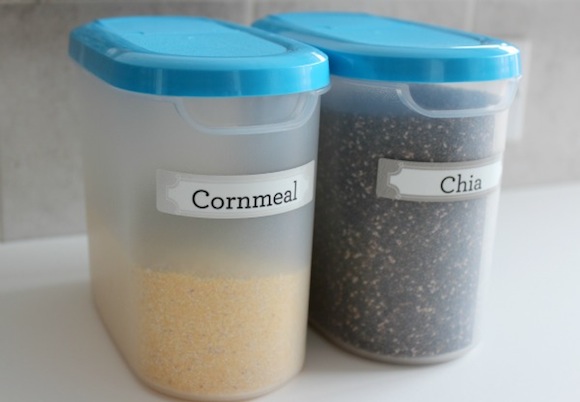Whether you’re prepping for an emergency or simply want to avoid a last-minute, pre-dinner trip to the store, the idea of a brimming pantry holds a great deal of appeal.
It also can cut costs. “Proper food storage prevents waste and thereby saves money,” said Teri Gault, CEO of The Grocery Game, which specializes in helping consumers save money on groceries.
To get the best deals on stored goods, start by stocking up on sale items at the store, Gault said.
Then, follow these seven straightforward strategies to create and maintain your food reservoir.
1. Switch Grains to Containers.
“Rice, barley and other grains can become rancid if stored in their original plastic bags,” Gault said.
To keep grains fresh longer, transfer them to airtight containers. When adding them to your pantry, place items with earlier expiration dates toward the front. Goods that will last longer can be put toward the back.
2. Organize Your Storage Area.
“It’s really important to label,” said Cathy Barrow, founder of Mrs. Wheelbarrow’s Kitchen and author of “Mrs. Wheelbarrow’s Practical Pantry.”
It’s not about being pretty, she said. You might use masking tape to mark the contents of a container and the date you stored the items.
When arranging a pantry, keep like-minded items together. Store cans of tomatoes on one shelf, and place jams and jellies on another. Keep one section open for miscellaneous items.
3. Take the Temperature.
If goods such as spices get too hot, the contents could spoil sooner or lose their flavor.
To avoid temperature fluctuations, keep pantry staples and seasonings away from the stove. If you live in a hot climate, refrain from storing goods along an outside wall or in the garage.
“When pantry items are stored at about room temperature, or between 72 and 85 degrees, they should be perfectly good until the date on the package,” Gault said.
4. Freeze Properly.
If you buy meat that’s close to its expiration date, freeze it right away, said Kim Pezza, author of “Backyard Farming: Home Harvesting” and other books on backyard farming. Wrap the meat well before labeling it and sticking it in the freezer.
“Some vegetables, such as broccoli, beans and cauliflower, should be blanched before freezing to retain color,” Pezza said.
To blanch them, place vegetables in boiling water for a short period and then transfer them to cold water.
Then, when ready to freeze, spread out on a cookie sheet and leave in the freezer for a few hours, Pezza suggested. When the vegetables have frozen, transfer them to a freezer bag and put the bag in the freezer. This prevents pieces from freezing together in one large lump. Berries and chicken parts also can be frozen this way.
5. Care for Fresh Produce.
When purchasing fruit, select some pieces that will ripen in a day or two, and others that will be ready later in the week. By staggering your produce, you’ll avoid having an overflowing bowl full of ripe fruit, Barrow said.
Keep potatoes in a cool place with plenty of ventilation—preferably outside the refrigerator, according to the United States Potato Board.
If you’re not sure how to keep fresh produce, visit StillTasty.com, which offers tips on properly storing a variety of fruits and vegetables.
6. Understand the Cans.
“Canned foods last the longest, even up to five years, as long as they’re not acid- or vinegar-based,” Gault said.
Acidic staples, such as canned tomatoes, as well as products that contain vinegar, like sauerkraut, generally last 12 to 18 months.
Check cans before using them. If the top or bottom lid of a can has expanded and popped up, it should be discarded. Also, if you push the lid down and it pops back up, the can should be tossed.
7. Keep Tabs on Stored Goods.
Whether it’s once a month or twice a year, schedule times to peruse your storage area.
Acknowledge what you have, discard anything that’s no longer fresh and rearrange as needed. By taking into account what you’ve got, you’ll be able to incorporate goods into meals while they’re at their peak.




